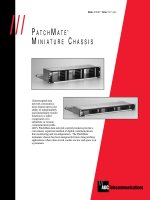Tài liệu Hibernate Tutorial 09 pptx
Bạn đang xem bản rút gọn của tài liệu. Xem và tải ngay bản đầy đủ của tài liệu tại đây (31.64 KB, 8 trang )
Page 1 of 8
Hibernate Tutorial 09 Hibernate Query Language
By Gary Mak
September 2006
1. Querying objects
When using JDBC to access databases, we write SQL statements for the query and update tasks. In
such case, we are dealing with tables, columns and joins. When using Hibernate, most update tasks
can be finished through the APIs provided by Hibernate. However, using a query language for the
query tasks is still necessary. Hibernate is providing a powerful query language called Hibernate
query language (HQL).
HQL is database independent and translated into SQL by Hibernate at runtime. When writing HQL,
we can concentrate on the objects and properties without knowing much detail on the underlying
database. We can treat HQL as an object-oriented variant of SQL.
In the previous chapters, we have already experienced some basic HQL statements for querying
objects. For example, we can use the following HQL to query for all books, and then call the list()
method to retrieve the result list which containing book objects.
Query query = session.createQuery("from Book");
List books = query.list();
The Query interface provides two methods for retrieving only a subset of the results, ranged by the
offset (which is zero-based) and record count. They are very useful for displaying the results in a
table with multiple pages.
Query query = session.createQuery("from Book");
query.setFirstResult(20);
query.setMaxResults(10);
List books = query.list();
Another query attribute that will have performance impact is the fetch size. It tells the underlying
JDBC driver how many rows should be transferred for a single request.
Query query = session.createQuery("from Book");
query.setFetchSize(100);
List books = query.list();
When using HQL, we can specify query parameters at the same way as we do for SQL queries. If
we are sure that there will be only one unique object returned as result, we can call the
uniqueResult() method to retrieve it. Null will be returned if nothing matched.
Page 2 of 8
Query query = session.createQuery("from Book where isbn = ?");
query.setString(0, "1932394419");
Book book = (Book) query.uniqueResult();
In the example above, we use “?” to represent a query parameter and set it by index, which is
zero-based not one-based as in JDBC. This kind of parameters is called “Positional Parameters”. We
can also use “Named Parameters” for our queries. The advantages of using named parameters are
easy to understand and able to occur for multiple times.
Query query = session.createQuery("from Book where isbn = :isbn");
query.setString("isbn", "1932394419");
Book book = (Book) query.uniqueResult();
In this tutorial, we will introduce more details about HQL. It is also beneficial to monitor the SQL
statements generated for writing high performance queries.
2. The from clause
Now let’s begin with the from clause of a HQL statement. It is the only necessary part of a HQL
statement. The following HQL statement is used for querying the books whose name contains the
word “Hibernate”. Notice that the “name” is a property of Book but not a database column.
from Book
where name = 'Hibernate Quickly'
Or you can assign an alias for the object. It’s useful when you are querying multiple objects in one
query. We should use the naming conventions for classes and instances in Java. Notice that the “as”
keyword is optional.
from Book as book
where book.name = 'Hibernate Quickly'
We can specify more than one class in the from clause. In such case, the result will contain a list of
Object[]. For the following statement, it will be a “cross join” of book objects and publisher objects
since there’s not any where clauses.
from Book book, Publisher publisher
3. Joining associations
In HQL, we can use the “join” keyword to join our associated objects. The following query finds all
the books published by the publisher “Manning”. The result contains a list of object pairs in the
form of Object[]. Each pair consists of a book object and a publisher object.
Page 3 of 8
from Book book join book.publisher publisher
where publisher.name = 'Manning'
In addition to many-to-one associations, all other kinds of associations can also be joined. For
example, we can join the one-to-many association from book to chapters as well. The following
query finds all the books containing a chapter “Hibernate Basics”. The result contains a list of
object pairs also. Each pair consists of a book object and a collection of chapters.
from Book book join book.chapters chapter
where chapter.title = 'Hibernate Basics'
3.1. Implicit Joins
In the above joins, we specify a keyword “join” for joining associated objects. This kind of joins is
called “explicit joins”. In fact, we can reference an association by its name directly. This will cause
an “implicit joins”. For example, the above two queries can be expressed as follows. The result will
contain a list of book objects only since no join is specified in the from clause.
from Book book
where book.publisher.name = 'Manning'
from Book book
where book.chapters.title = 'Hibernate Basics'
For a collection association, an implicit join occurs each time when it is navigated. That means if
we navigate the same collection for two times, the same table will be joined for two times also.
from Book book
where book.chapters.title = 'Hibernate Basics' and book.chapters.numOfPages = 25
So we must be careful when using implicit joins with collection association. For the collection to be
referenced more than one time, we should use “explicit join” to avoid duplicated joins.
from Book book join book.chapters chapter
where chapter.title = 'Hibernate Basics' and chapter.numOfPages = 25
3.2. Joining types
If we use the following HQL to query for books joining with publishers, we will find that the books
with null publisher will not be included. This type of joins is called “inner join” and it is default for
joins if we don’t specify any join type or specify as “inner join”. It has the same meaning as the
inner join in SQL.
from Book book join book.publisher
Page 4 of 8
If we want to get all the books regardless whose publisher is null or not, we can use the “left join”
by specifying “left join” or “left outer join”.
from Book book left join book.publisher
There are another two types of joins supported by HQL, “right join” and “full join”. They have the
same meaning as in SQL also, but are seldom used.
3.3. Removing duplicate objects
The following HQL can be used to retrieve books and their associated chapters where at least one of
the chapter titles includes the word “Hibernate”. The result contains pairs of a book and a chapter.
from Book book join book.chapters chapter
where chapter.title like '%Hibernate%'
For the implicit version of the above query, only the book objects will be included. But to our
surprise the book objects are duplicated. The time of duplication is equal to how many chapters
have “Hibernate” like title.
from Book book
where book.chapters.title like '%Hibernate%'
According to the explanation given by Hibernate, it is a normal behavior since Hibernate always
returns a list of the same size as the underlying JDBC ResultSet. We can use a LinkedHashSet to
filter the duplicate objects while keeping the order of original list.
Query query = session.createQuery(
"from Book book where book.chapters.title like '%Hibernate%'");
List books = query.list();
Set uniqueBooks = new LinkedHashSet(books);
3.4. Fetching associations
We can use “join fetch” to force a lazy association to be initialized. It differs from the pure “join” in
that only the parent objects will be included in the result.
from Book book join fetch book.publisher publisher
The above “inner join fetch” query will not return book objects with null publisher. If you want to
include them also, you should use “left join fetch”.
from Book book left join fetch book.publisher publisher
Page 5 of 8
4. The where clause
In HQL, we can use where clauses to filter the results just like what we do in SQL. For multiple
conditions, we can use “and”, “or”, “not” to combine them.
from Book book
where book.name like '%Hibernate%' and book.price between 100 and 200
We can check whether an associated object is null or not by “is null” or “is not null”. Notice that a
collection can not be checked.
from Book book
where book.publisher is not null
We can also use implicit joins in the where clause. Remember that for collection association, if you
reference it more than one time, you should use “explicit join” to avoid duplicated joins.
from Book book
where book.publisher.name in ('Manning', 'OReilly')
Hibernate is providing a function for you to check the size of a collection. You can use it by the
special property size or the special size() function. Hibernate will use a “select count(...)” subquery
to get the size of the collection.
from Book book
where book.chapters.size > 10
from Book book
where size(book.chapters) > 10
5. The select clause
In the previous samples, we are querying for the whole persistent objects. We can query for some
particular fields instead in the select clause. For example, the following query returns all the book
names in a list.
select book.name
from Book book
The SQL aggregate functions, such as count(), sum(), avg(), max(), min() can be used in HQL also.
They will be translated in the resulting SQL.
select avg(book.price)
from Book book









